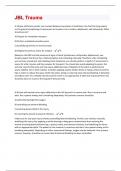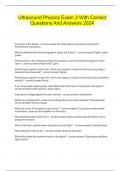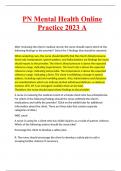JBL Trauma
A 33-year-old factory worker was crushed between two pieces of machinery. You find him lying supine
on the ground complaining of severe pain to his pelvis. He is restless, diaphoretic, and tachycardic. What
should you do?
A) Prepare for immediate transport
B) Perform a detailed secondary exam
C) Carefully log roll him to check his back
D) Palpate his pelvis to assess for crepitus - A
(Based on the MOI and the presence of signs of shock [restlessness, tachycardia, diaphoresis], you
should suspect that the pt has a fractured pelvis and is bleeding internally. Therefore, after completing
your primary assessment and initiating shock treatment, you should perform a rapid H>T assessment to
assess for other injuries and then prepare for transport. You should also avoid palpating his pelvis; this
will only cause further pain and may cause additional injury. Palpation of the pelvis is performed to
assess stability, not to elicit crepitus. Consider applying a pelvic binder device or tying a sheet around his
hips in order to reduce the space within the pelvis; doing so may help slow internal bleeding. A detached
secondary exam of a critically injured pt at the scene is not appropriate; it takes too long to perform and
should be done en route to the hospital if time permits)
A 30-year-old woman has an open deformity to her left leg and is in severe pain. She is conscious and
alert, has a patent airway, and is breathing adequately. Your primary concern should be:
A) administering high-flow oxygen.
B) controlling any external bleeding.
C) assessing pulses distal to the injury.
D) covering the wound to prevent infection. - B
Initial care for any open injury involves controlling external bleeding. Further care involves manually
stabilizing the injury site; applying a sterile dressing to keep gross contaminants from entering the
wound; assessing distal perfusion (eg, a pulse), motor, and sensory functions; and stabilizing the injury
with an appropriate splint. The patient in this scenario is conscious and alert, has a patent airway, and is
breathing adequately. Depending on other assessment findings, oxygen may be indicated. Your primary
concern, however, should be to ensure that all external bleeding has been controlled.
,A 22-year-old female fell on her knee and is in severe pain. Her knee is flexed and severely deformed.
Her leg is cold to the touch and you are unable to palpate a distal pulse. You should:
A) apply gentle longitudinal traction as you straighten her leg and then apply a traction splint.
B) place a pillow behind her knee and stabilize the injury by applying padded board splints.
C) carefully straighten her leg until you restore a distal pulse and then apply padded board splints.
D) manually stabilize her injury and contact medical control for further stabilization instructions. -
D
(A dislocated knee occurs when the proximal end of the tibia completely displaces from its juncture with
the distal femur. In some cases, the popliteal artery behind the knee may be compressed, resulting in
compromised distal blood flow. Signs of this include absent distal pulses and a pale extremity that is cool
or cold. Manually stabilize the knee and assess for distal pulses. If distal pulses are absent, contact
medical control immediately for further stabilization instructions. Medical control may instruct you to
make ONE attempt to realign the knee to reduce compression of the popliteal artery to restore
circulation. If you are unable to restore distal circulation or medical control advises you no two
manipulate the injury, splint the knee in the position it was found and transport. Traction splints are
contraindicated in any injury to to near the knee)
A 22-year-old man had a strong acid chemical splashed into both of his eyes. He is conscious and alert, is
experiencing intense pain, and states that he is wearing contact lenses. Treatment should include:
A) leaving the contact lenses in and beginning irrigation of both eyes.
B) removing the contact lenses and beginning irrigation of both eyes.
C) leaving the contact lenses in and covering both eyes with sterile gauze.
D) removing the contact lenses and covering both eyes with sterile gauze. - B
As a general rule, contact lenses should be left in place. Chemical eye burns are an exception to this rule.
If left in place, the chemical could get behind the contact lens and continue to cause injury. Therefore,
you should remove the contact lenses and immediately irrigate the eyes with sterile saline or water. If
needed, continue to irrigate the eyes throughout transport.
A 22-year-old woman fell on her knee and is in severe pain. Her knee is flexed and severely deformed.
Her leg is cold to the touch and you are unable to palpate a distal pulse. You should:
A) apply gentle longitudinal traction as you straighten her leg and then apply a traction splint.
B) place a pillow behind her knee and stabilize the injury by applying padded board splints.
C) carefully straighten her leg until you restore a distal pulse and then apply padded board splints.
,D) manually stabilize her injury and contact medical control for further stabilization instructions. -
D
A dislocated knee occurs when the proximal end of the tibia completely displaces from its juncture with
the distal femur. In some cases, the popliteal artery behind the knee may be compressed, resulting in
compromised distal blood flow. Signs of this include absent distal pulses and a pale extremity that is cool
or cold. Manually stabilize the knee and assess for distal pulses. If distal pulses are absent, contact
medical control immediately for further stabilization instructions. Medical control may instruct you to
make ONE attempt to realign the knee to reduce compression of the popliteal artery and restore distal
circulation. If you are unable to restore distal circulation or medical control advises you not to
manipulate the injury, splint the knee in the position it was found and transport promptly. Traction
splints are contraindicated in any injury to or near the knee.
A 23-year-old male was struck across the face with a baseball bat. His eyes are swollen shut, he has
massive facial bruising and deformities, and he has blood in his mouth. Your MOST immediate concern
should be:
A) spinal trauma.
B) intracranial bleeding.
C) airway compromise.
D) permanent vision loss. - C
A 30-year-old man sustained partial-thickness burns to the anterior chest and both anterior arms. Based
on the Rule of Nines, what percentage of his body surface area has been burned?
A) 9%
B) 18%
C) 27%
D) 36% - B
(Anterior trunk [chest and abdomen] accounts for 18% of the TBSA and each entire arm accounts for 9%.
Therefore, the anterior chest, which is one half of the trunk, would account for 9% of the TBSA, and both
anterior arms [4.5%] would account for 9% TBSA)
, A 33-year-old male struck a parked car with his motorcycle and was thrown from the motorcycle. He was
not wearing a helmet. He is unresponsive and has a depressed area to his forehead, bilaterally deformed
femurs, and widespread abrasions with capillary bleeding. Which of the following statements regarding
this patient is false?
A) You should suspect that the patient has a skull fracture and increased intracranial pressure.
B) Femur fractures are a common injury when a rider is thrown from his or her motorcycle.
C) Internal hemorrhage cannot be controlled in the field and requires prompt surgical intervention.
D) You must stop the bleeding from his abrasions immediately or the patient will die from hypovolemic
shock. - D
A 33-year-old man struck a parked car with his motorcycle and was thrown from the motorcycle. He was
not wearing a helmet. He is unresponsive and has a depressed area to his forehead, bilaterally deformed
femurs, and widespread abrasions with capillary bleeding. Which of the following statements regarding
this patient is false?
A) You should suspect that the patient has a skull fracture and increased intracranial pressure.
B) Femur fractures are a common injury when a rider is thrown from his or her motorcycle.
C) Internal hemorrhage cannot be controlled in the field and requires prompt surgical intervention.
D) You must stop the bleeding from his abrasions immediately or the patient will die from hypovolemic
shock. - D
The patient's abrasions (road rash) and capillary bleeding are the least of his problems. Capillary
bleeding, blood that oozes from the capillary beds, is the least severe type of external bleeding and will
not kill your patient. Wasting time at the scene to cover his abrasions, however, will delay definitive care
at a trauma center; this may kill him! The patient likely has a depressed skull fracture, and the fact that
he is unresponsive indicates a traumatic brain injury with increased intracranial pressure. When a rider is
thrown from his or her motorcycle, the femurs typically strike the handlebars, resulting in unilateral or
bilateral fractures. You cannot control internal hemorrhage in the field, regardless of your level of
training. Internal bleeding requires surgical intervention; therefore, you must transport the patient
without delay.
A 40-year-old man has burns to the entire head, anterior chest, and both anterior upper extremities.
Using the adult Rule of Nines, what percentage of his total body surface area has been burned?
A) 18%
B) 27%
C) 36%
D) 45% - B






